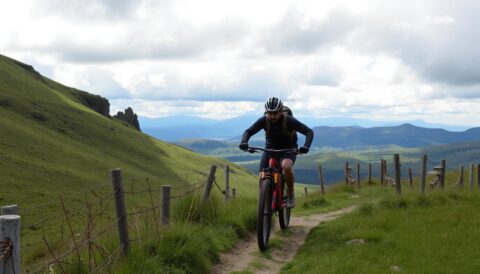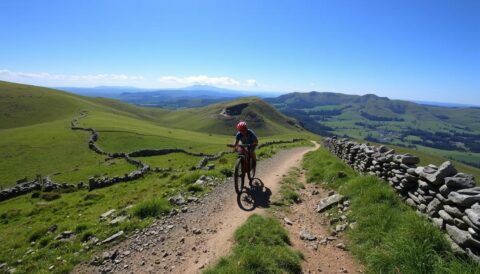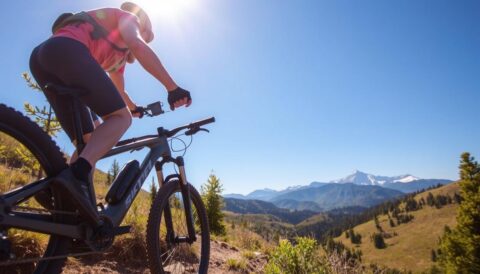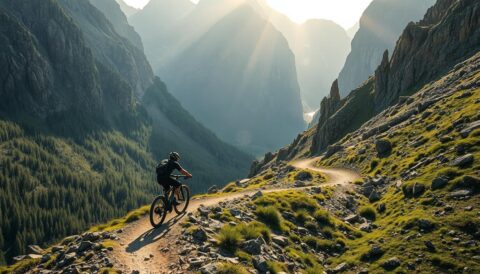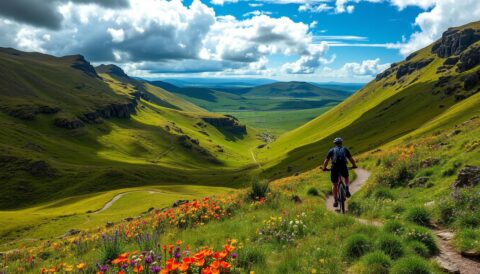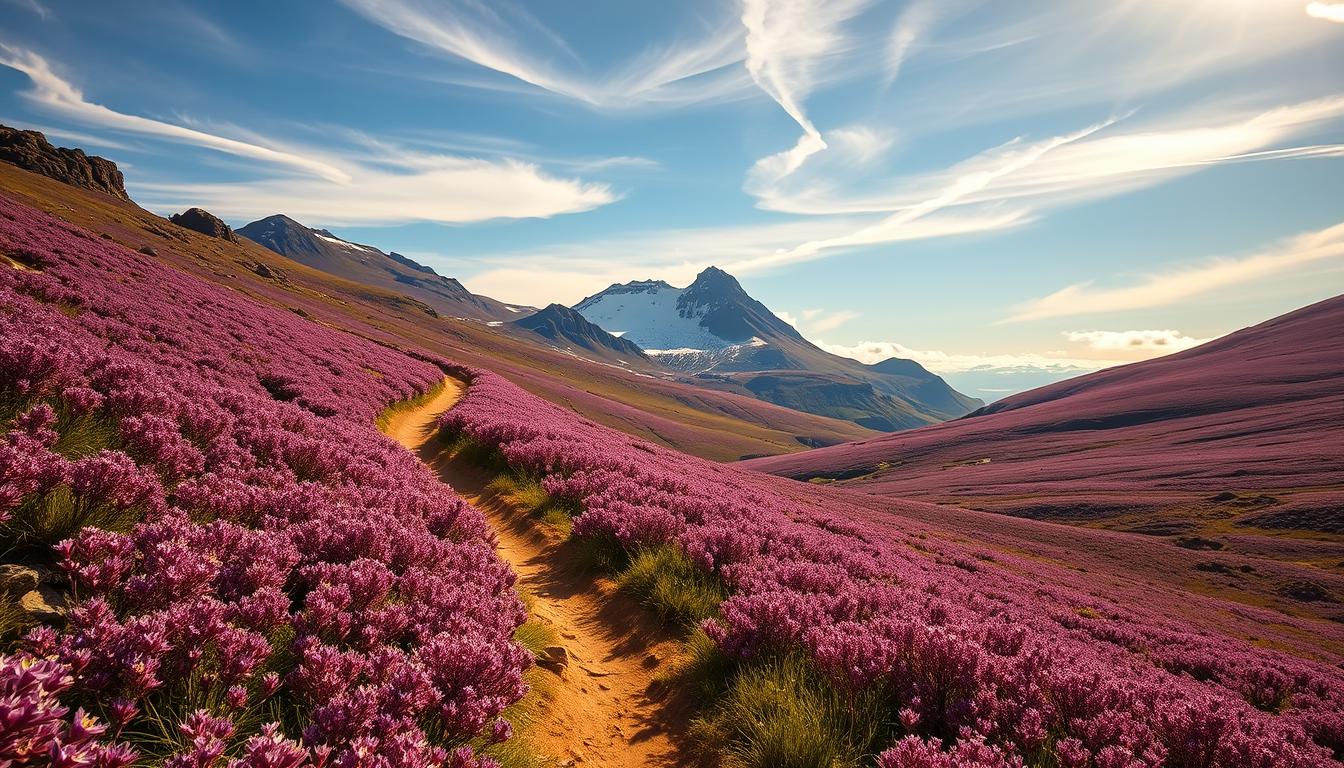Stretching 268 miles from Derbyshire to the Scottish Borders, the Pennine Way is one of the UK’s most iconic trails. Known as the “backbone of England,” it offers a thrilling mix of rugged terrain, UNESCO-protected landscapes, and historic landmarks. For those seeking an unforgettable adventure, this route is a must-try.
Cyclists are drawn to the trail for its challenging climbs and remote sections, which test both skill and endurance. Along the way, you’ll pass through picturesque villages in the Yorkshire Dales and encounter remnants of Roman roads. It’s not just a physical challenge but also a journey through history and culture.
This guide aims to help riders prepare for multi-day adventures, whether tackling the Pennine Bridleway or extending their trip as part of the Great North Trail network. With careful planning, you can experience the perfect blend of adrenaline and exploration.
Key Takeaways
- The Pennine Way spans 268 miles, offering a mix of rugged terrain and stunning landscapes.
- Cyclists can explore UNESCO-protected areas and historic landmarks along the route.
- Prepare for technical climbs and remote sections to ensure a smooth journey.
- The trail is part of the Great North Trail network, ideal for extended bikepacking trips.
- Experience the charm of Yorkshire Dales villages while enjoying the ride.
Introduction to the Pennine Way
From Wirksworth Station to Kirkby Stephen, this trail offers a journey through time and terrain. The Pennine Bridleway, stretching 296km with 5,900m of ascent, is a modern marvel built on ancient packhorse routes. Established in 2012, it connects five counties: Derbyshire, Greater Manchester, Lancashire, Yorkshire Dales, and Cumbria.
This long-distance route is more than just a trail; it’s a gateway to England’s natural and cultural heritage. The North Pennines, a UNESCO Global Geopark, adds to its allure with stunning landscapes and rich geology. Whether you’re hiking or cycling, the hills and valleys provide a challenging yet rewarding experience.
While hikers have long enjoyed this route, cyclists will find specific sections permitted for mountain biking. The trail’s connection to the 1,200km Great North Trail makes it ideal for ambitious riders seeking extended adventures. Over the years, the Pennine Bridleway has evolved into a must-visit destination for outdoor enthusiasts.
Passing through a national park and diverse terrains, this trail offers something for everyone. Its history, combined with modern accessibility, makes it a unique experience. Whether you’re exploring its ancient roots or tackling its climbs, the Pennine Bridleway promises an unforgettable journey.
Why Choose the Pennine Way for Mountain Biking?
With its diverse landscapes and challenging climbs, the Pennine Way is a dream for off-road enthusiasts. The trail combines grassy singletrack (32%), gravel tracks (45%), and technical rocky sections (23%), offering a varied terrain that keeps riders engaged. Iconic climbs like Thwaite Scar, with its 18% gradient, test even the most experienced cyclists.
For those used to road cycling, the adventure here is unmatched. Descending Trow Gill’s limestone pavement delivers an adrenaline rush like no other. The trail’s remote sections provide a sense of solitude, making it a perfect escape from the hustle and bustle of daily life.
Photographers will love the unique opportunities along the route. Capture the Ribblehead Viaduct at sunset or spot Curlews on the moorlands. These moments add to the trail’s charm and make for unforgettable memories.
Completing this route is a badge of honour. It’s one of Britain’s toughest trail rides, and finishing it is a challenge worth bragging about. With 85% of the route accessible year-round, proper preparation ensures a smooth journey.
“Some of the very best off-road riding in the North.”
| Terrain Type | Percentage |
|---|---|
| Grassy Singletrack | 32% |
| Gravel Tracks | 45% |
| Technical Rocky Sections | 23% |
Planning Your Pennine Way Adventure
To make the most of your adventure, timing and route selection are crucial. Proper preparation ensures a smooth and enjoyable experience on this challenging trail. Whether you’re a seasoned rider or a first-timer, understanding the best time to ride and the available route options will set you up for success.
Best Time to Ride
The optimal months for tackling this trail are May to June and September to October. These periods offer milder weather and fewer crowds compared to the busy summer months. July and August can be warmer, but frequent rain showers and crowded trails may dampen the experience.
Northern sections of the trail close from November to March due to snow, making winter rides impractical. Shoulder seasons provide quieter trails and pleasant riding conditions, though you should prepare for microclimates. For instance, Cross Fell, the highest point, is often shrouded in fog.
Route Overview
There are several route variants to suit different skill levels and timeframes. A 5-day standard itinerary allows for a balanced pace, while a 3-day endurance challenge is ideal for experienced riders. The trail passes through the dark peak, offering stunning views and technical sections.
Essential apps like OS Maps are invaluable for offline navigation, especially in areas with limited mobile coverage, such as between Keld and Alston. Planning your stops and accommodations in advance ensures a seamless journey.
| Route Variant | Duration | Difficulty |
|---|---|---|
| Standard Itinerary | 5 Days | Moderate |
| Endurance Challenge | 3 Days | Advanced |
Essential Gear for Mountain Biking the Pennine Way
Preparing for a long-distance trail requires the right gear to tackle its challenges. From bike selection to clothing, every choice impacts your experience. This section covers everything you need to know to stay comfortable and safe on the trail.
Bike Recommendations
Selecting the right bike is crucial for handling the trail’s technical sections and steep climbs. The Giant Trance X E+2 e-MTB is highly recommended for its ability to tackle gradients up to 25%. For limestone slab sections, consider the pros and cons of hardtail vs full-suspension bikes.
- Hardtail: Lightweight and efficient on smoother terrain.
- Full-Suspension: Better control and comfort on rocky, uneven paths.
Mandatory features include tubeless tyres (minimum 2.4″), 4-piston brakes, and a 3L hydration pack. For e-bike riders, charging points are available in Settle and Hawes.
Clothing and Accessories
Layering is key to adapting to changing weather conditions. Start with a merino base layer for warmth and moisture control. Add a hardshell jacket for waterproofs and wind protection. Don’t forget gloves and padded shorts for comfort during long rides.
Essential spares include chain links, derailleur hangers, and a multi-tool with a chain breaker. Safety gear like emergency bivvy bags is vital for remote areas. A well-prepared kit ensures you’re ready for any situation.
| Gear Type | Recommendation |
|---|---|
| Bike | Giant Trance X E+2 e-MTB |
| Tyres | Tubeless, 2.4″ minimum |
| Brakes | 4-piston |
| Hydration | 3L pack |
| Safety | Emergency bivvy bag |
Navigating the Terrain
Tackling the varied landscapes of this iconic route requires a keen understanding of its climbs and technical sections. The trail’s mix of steep ascents and rocky descents demands both skill and preparation. Proper navigation ensures a smoother and more enjoyable journey.
Understanding the Climb
Day 2 of the route features a challenging 1,720m ascent over 73.5km. Gradients often exceed 15%, particularly on Days 2 and 5. These climbs test endurance and require careful gear selection.
Local wisdom suggests walking the first 100m of the Pen-y-ghent descent. This approach helps riders assess the terrain and avoid potential hazards. Proper gear ratios, such as a 30T chainring with a 51T cassette, are essential for tackling these steep sections.
Technical Sections
The trail’s technical features add an extra layer of challenge. Drainage channels on Cam High Road and exposed rock gardens on the “Cut Gate” descent require precise line choice. Marsden Moor’s peat hags are another tricky section, demanding focus and skill.
For rocky descents, full-suspension bikes offer better control and comfort. Tubeless tyres, at least 2.4″ wide, provide added grip and puncture resistance. These adjustments make navigating technical sections more manageable.
- Gradient profiles: Be prepared for 15%+ climbs on key days.
- Line choice: Assess terrain carefully, especially on peat hags and rock gardens.
- Gear ratios: Opt for a 30T chainring with a 51T cassette for steep climbs.
Accommodation Along the Route
From cosy B&Bs to unique stays, the route offers plenty of places to recharge. With 23 designated cyclist-friendly B&Bs within 2km of the trail, you’ll find options to suit every preference and budget. Whether you’re seeking luxury or simplicity, there’s something for everyone.
For those who enjoy a touch of indulgence, luxury inns in Hebden Bridge provide a comfortable end to a day’s ride. Alternatively, bothy stays like Gregory Hut offer a rustic experience, perfect for those who prefer a more adventurous night under the stars. Wild camping is prohibited except at three designated bothy sites, so plan accordingly.
Unique stays add charm to your journey. Consider the converted railway carriage near Dent Station for a memorable overnight experience. These quirky options make your trip even more special.
Multi-day riders can take advantage of baggage transfer services, allowing you to travel light and focus on the ride. It’s a convenient way to make your journey smoother and more enjoyable.
“Booking early ensures you get the best spots, especially during peak seasons.”
To secure your preferred accommodation, it’s wise to book ahead. For July dates, reservations should ideally be made six months in advance. Key hotels also offer 24-hour bike storage facilities, ensuring your equipment is safe and secure.
| Accommodation Type | Features |
|---|---|
| Luxury Inns | Comfort, amenities, cyclist-friendly |
| Bothy Stays | Rustic, remote, budget-friendly |
| Unique Stays | Memorable, quirky, scenic locations |
Exploring the countryside is even more rewarding when you have a comfortable place to rest. With careful planning, your accommodation can enhance your adventure along this iconic route.
Transportation and Access Points
Planning your journey to the trailhead is just as important as the ride itself. Whether you’re arriving by train or car, the route is well-connected, making it easy to reach the starting point. This section covers everything you need to know about transport options, bike carriage policies, and parking facilities.
Getting to the Start
Manchester Airport and Newcastle are the main transport hubs for accessing the trail. Both offer excellent connections to nearby train stations. For those driving, long-stay car parks in Kirkby Stephen are available at £6 per day. Additionally, EV charging points are conveniently located in trailhead villages, ensuring your vehicle is ready for the return trip.
Taking Your Bike on Trains
Train travel is a popular choice for cyclists. Northern Rail allows up to two bikes per train without prior booking, making it a flexible option. However, TransPennine Express requires a £3 advance reservation for bike carriage. Always check the specific policies of your chosen operator to avoid any last-minute surprises.
For those needing additional transport, taxi firms like Dalesman Transport Co. offer bike trailers, ensuring your equipment arrives safely. Whether you’re travelling by train or car, these options make reaching the trail straightforward and stress-free.
| Transport Option | Details |
|---|---|
| Train (Northern Rail) | 2 bikes/train, no booking required |
| Train (TransPennine Express) | £3 advance bike reservation |
| Car Parking | Long-stay in Kirkby Stephen (£6/day) |
| Taxi Services | Bike trailers available (e.g., Dalesman Transport Co.) |
| EV Charging | Available in trailhead villages |
Training and Fitness Preparation
Building the right fitness level is essential for tackling challenging terrains over multiple days. A 12-week preparation plan is highly recommended, especially for casual riders. This structured approach ensures you’re ready for the physical demands of a long-distance adventure.
Start with base miles to build endurance. Gradually introduce hill repeats to strengthen your legs and improve stamina. Finally, incorporate loaded rides to simulate the weight you’ll carry during the actual journey. A good benchmark is achieving 5 hours of saddle time with a 10kg pack.
For local prep rides, the Peak District’s Dark Peak routes are ideal. These trails offer a mix of climbs and descents, helping you get accustomed to varied terrain. Practising on similar routes will make the actual ride feel less daunting.
Nutrition plays a crucial role in back-to-back riding days. Focus on a balanced diet rich in carbohydrates, proteins, and healthy fats. During the ride, energy gels and hydration tablets can help maintain your energy levels.
Over the years, cyclists have emphasised the importance of core strength for technical descents. Exercises like planks and Russian twists can improve stability and control, making tricky sections easier to navigate.
“A strong core is your best friend on technical trails.”
Remember, preparation is key. A bit of effort in training can make a world of difference on the trail. With the right plan, you’ll be ready to tackle any challenge that comes your way.
| Training Phase | Focus |
|---|---|
| Base Miles | Endurance |
| Hill Repeats | Strength |
| Loaded Rides | Simulation |
Safety Tips for Remote Riding
Safety is paramount when venturing into isolated sections of long-distance trails. With an average of 12 Mountain Rescue callouts annually, being prepared can make all the difference. Here’s how to ensure a secure journey.
First, equip yourself with mandatory safety gear. A GPS emergency beacon (PLB) and a first-aid course certification are essential. These tools can be lifesavers in critical situations. Additionally, always carry a well-stocked first-aid kit and know how to use it.
Weather in remote areas can change rapidly. Sudden fog on High Cup Nick, for example, can reduce visibility to almost zero. Check forecasts before setting out and pack layers to adapt to shifting conditions. Waterproof clothing is a must, especially in unpredictable climates.
In case of an emergency, use What3Words for precise location sharing. This system divides the world into 3m squares, making it easier for rescuers to find you. It’s a simple yet effective way to communicate your exact position.
For isolated sections, riding in groups is highly recommended. A minimum of three riders ensures that if one person is injured, another can stay with them while the third seeks help. This approach minimises risks and enhances safety.
Finally, keep a list of ranger contact numbers for each National Park section. These professionals are familiar with the terrain and can provide assistance if needed. Staying informed and prepared is the best way to handle unexpected challenges.
“Preparation is the key to a safe and enjoyable adventure in remote areas.”
For more tips on handling challenging terrains, check out this guide on safely managing high speeds. Remember, a little preparation goes a long way in ensuring a smooth and secure ride.
Exploring Off the Bike
The area surrounding the trail is rich with historic ruins and charming towns waiting to be explored. With 15 English Heritage sites within 5km of the route, history enthusiasts will find plenty to admire. From ancient structures to cultural landmarks, there’s something for everyone.
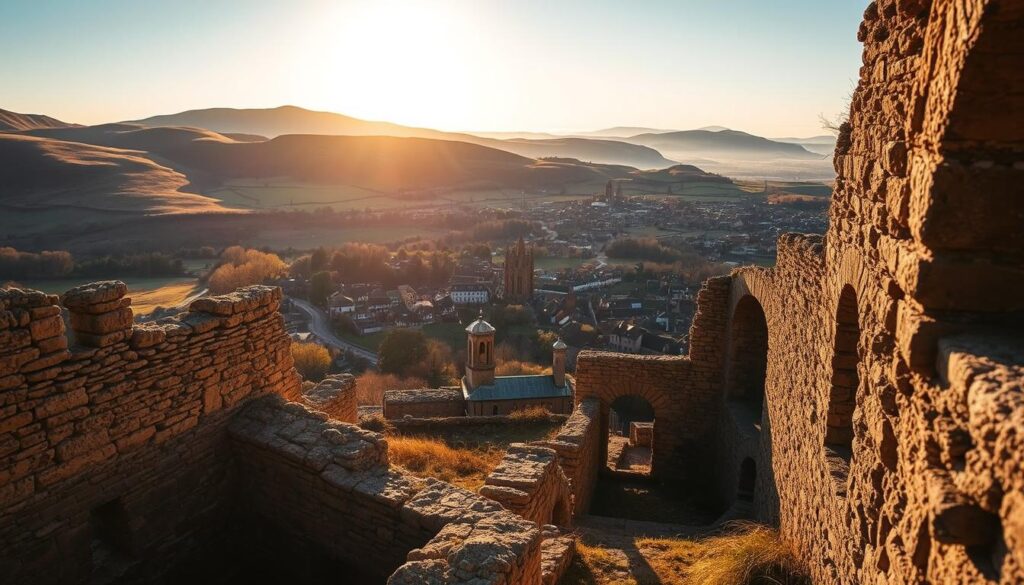
Hebden Bridge, named the UK’s quirkiest market town in 2023, is a must-visit. Its vibrant streets are filled with independent shops, cafes, and art galleries. The town’s unique charm makes it a perfect stop to relax and soak in the local culture.
For natural wonders, head to Malham Cove. This stunning limestone pavement offers breathtaking views and a chance to connect with nature. Families will enjoy picnic spots along the South Tynedale Railway, while foodies can indulge in cheese tasting at Wensleydale Creamery.
Cultural highlights include Settle’s Victorian music hall, the oldest in the UK. It’s a fantastic place to experience live performances and step back in time. As the day ends, don’t miss stargazing in the Yorkshire Dales Dark Sky Reserve. The clear night skies are a magical way to conclude your adventure.
Day-by-Day Itinerary
Breaking down the journey into manageable stages helps riders pace themselves while soaking in the highlights. Each day offers distinct challenges and rewards, from steep ascents to charming pit stops. Here’s what to expect on this epic five-day adventure.
Day 1: Wirksworth to Hayfield
Covering 61km with 900m of ascent, the first leg eases riders into the route. Key climbs include Middleton Top, where gradients reach 12%. Resupply at Cromford’s historic mills before tackling the limestone descent into Hayfield.
- Photo stop: High Peak Junction’s preserved railway
- Accommodation: Kinder Lodge bunkhouse (cyclist discounts)
Day 2: Hayfield to Hebden Bridge
This 58km section features Rushup Edge’s notorious rock slabs – a technical test for even seasoned riders. The 1,150m climb rewards with panoramic views from Mam Tor. Refuel at Edale’s Penny Pot Café before descending through Calder Valley.
Day 3: Hebden Bridge to Earby
A shorter 42km ride allows time to explore Haworth’s Brontë country. The day’s highlight is the 18% gradient at Thwaite Scar. Don’t miss:
- Cultural detour: Ponden Hall (Wuthering Heights inspiration)
- Evening stay: Earby’s converted textile mill hostel
Day 4: Earby to Clapham
Following part of the Three Peaks CX race route, this 47km leg crosses Malham Cove’s limestone pavement. The Buck Inn offers legendary Yorkshire puddings – perfect post-ride fuel. Overnight at Clapham’s 17th-century coaching inn.
Day 5: Clapham to Kirkby Stephen
The grand finale: 61km with a gruelling 1,280m climb. Conquer the iconic Ribblehead Viaduct before the final push through Yorkshire Dales’ remote moorlands. Celebrate at Kirkby Stephen’s Freemasons Arms with locally brewed ales.
| Day | Distance | Ascent | Key Feature |
|---|---|---|---|
| 1 | 61km | 900m | Middleton Top climb |
| 2 | 58km | 1,150m | Rushup Edge slabs |
| 3 | 42km | 780m | Thwaite Scar |
| 4 | 47km | 950m | Malham Cove |
| 5 | 61km | 1,280m | Ribblehead Viaduct |
“Day 2’s rock slabs separate the casual riders from the committed – choose your line wisely!”
Mountain Biking the Pennine Way: A Personal Experience
Embarking on the Pennine Way by bike is more than just a ride; it’s a journey through some of the UK’s most breathtaking landscapes. With a 67% completion rate for first-time riders and an average difficulty rating of 3.5/5, this trail offers both challenge and reward. Here’s a glimpse into my unforgettable adventure.
One of the most intense moments was battling hail on the Cross Fell plateau. The weather shifted rapidly, turning a serene ride into a test of endurance. Despite the harsh conditions, the experience was exhilarating, reminding me why I love exploring the countryside.
Memorable encounters included spotting fell ponies near Tan Hill Inn. These hardy creatures are a symbol of the rugged beauty of the area. Their presence added a touch of magic to the journey, creating lasting memories.
One crucial lesson I learned was the importance of carrying spare brake pads. The trail’s technical sections can be unforgiving, and having the right spares ensured I could continue without major disruptions. It’s a tip I’d highly recommend to fellow riders.
One of the most magical moments was pedalling through the Ribblehead mist at sunrise. The ethereal atmosphere made the effort worthwhile, offering a serene start to the day. It’s these moments that make the challenge of the trail so rewarding.
Finally, the post-ride tradition of dipping wheels in the North Sea marked the end of an incredible journey. It’s a symbolic gesture that celebrates the completion of this epic adventure.
| Highlight | Experience |
|---|---|
| Cross Fell Plateau | Battling hail in challenging weather |
| Tan Hill Inn | Encountering fell ponies |
| Technical Sections | Importance of spare brake pads |
| Ribblehead | Sunrise pedalling through mist |
| North Sea | Post-ride wheel dipping tradition |
Over the years, the Pennine Way has become a rite of passage for cyclists. It’s not just about the physical challenge but also the stories and memories created along the way. Whether you’re a seasoned rider or a first-timer, this trail promises an adventure like no other.
Environmental Considerations
Exploring the Pennine Way offers a chance to connect with nature while minimising environmental impact. As a route that passes through a national park and the countryside, it’s essential to ride responsibly and protect the natural beauty of the area.
A £5 Conservation Fee is included in National Trust Scotland (NTS) permits. This fee supports ongoing projects like the 2023 peat restoration in the Dark Peak. Such initiatives help preserve the fragile ecosystems along the trail.
Adhering to “Leave No Trace” rules is crucial for trailside camping. Pack out all waste, avoid disturbing wildlife, and camp only in designated areas. These practices ensure the way remains pristine for future adventurers.
Seasonal trail closures are in place to protect ground-nesting birds. Respect these closures to minimise disruption to their habitats. It’s a small step that makes a big difference.
Eco-friendly bike wash stations are available in trail towns. Use these facilities to clean your bike without harming the environment. It’s a simple way to reduce your impact.
Responsible riding includes avoiding skid turns on peat. This practice prevents erosion and preserves the natural terrain. Smooth, controlled movements are key to protecting the countryside.
Recycling points are available for inner tubes and energy gel wrappers. Proper disposal of waste helps keep the trail clean and sustainable. Here’s a quick guide to recycling points:
| Item | Recycling Point |
|---|---|
| Inner Tubes | Trailhead Villages |
| Energy Gel Wrappers | Designated Bins |
By following these guidelines, you can enjoy the Pennine Way while ensuring it remains a treasure for generations to come. Every small action contributes to the preservation of this iconic route.
Additional Resources
To ensure a seamless adventure, having the right resources at your fingertips is essential. Whether you’re planning your route or navigating the trail, these tools and guides will enhance your experience.
Start with the official Pennine Bridleway Guidebook (ISBN: 978-1-85284-564-6). This comprehensive guide offers detailed insights into the trail, including maps and historical context. For digital navigation, consider the OS Maps Premium membership, which provides a 40% discount on trail access.
Here’s a list of must-have resources:
- Essential Reading: Cicerone’s Pennine Cycleway Guide is a fantastic companion for planning and on-the-go reference.
- Recommended Apps: Trailforks offers real-time updates on surface conditions, helping you navigate tricky sections with ease.
- Local Guiding Companies: Peak MTB Tours provides supported trips, ideal for those new to the area or seeking expert guidance.
- Bike Hire Outlets: Pedal Progression delivers e-MTBs directly to your starting point, ensuring you have the right equipment.
- Weather Resources: Check the MWIS Pennines forecast page for accurate, up-to-date weather predictions.
For those who prefer digital tools, downloading GPX files can simplify navigation. These files are compatible with most GPS devices and apps, ensuring you stay on track even in remote areas.
With these resources, you’ll be well-prepared to tackle the trail and make the most of your cycling adventure. Happy riding!
Conclusion
Completing this trail is a badge of honour for any cyclist. It’s a true test of skill and endurance, offering unforgettable memories along the way. As you push your limits, remember to respect both the path and your own boundaries.
For those seeking their next adventure, Scotland’s Highland Trail 550 is an excellent progression route. It builds on the skills and stamina you’ve developed here. Always prioritise safety—better to bail than risk injury.
As you reach the end of your journey, take a moment to reflect on the years of stories and experiences this trail has inspired. Share your ride photos with #PenninePedallers and join a community of like-minded explorers.
FAQ
What’s the best time of year to ride the Pennine Way?
Late spring to early autumn (May to September) is ideal. The weather is milder, and trails are less likely to be boggy. Avoid winter months due to harsh conditions.
How long does it take to complete the route by bike?
Most riders take 4 to 6 days, depending on fitness levels and daily distances. Plan for around 40-50 miles per day.
What type of bike is best for this adventure?
A sturdy mountain bike with good suspension and wide tyres is essential. Gravel bikes can work for experienced riders but may struggle on technical sections.
Are there places to stay along the route?
Yes, you’ll find B&Bs, hostels, and campsites in towns like Hebden Bridge, Kirkby Stephen, and Clapham. Booking ahead is recommended, especially in peak season.
Can I take my bike on trains to the start point?
Yes, most UK trains allow bikes, but check with the operator for specific rules. Some services require reservations, particularly during busy times.
Is the route suitable for beginners?
It’s challenging, with steep climbs and technical descents. Intermediate to advanced riders will enjoy it more, but beginners can tackle shorter sections with preparation.
What should I pack for the ride?
Bring waterproof clothing, spare parts, a repair kit, and plenty of snacks. A GPS or map is crucial for navigation, as some areas are remote.
Are there any safety tips for remote riding?
Always carry a first aid kit, let someone know your plans, and check the weather before setting off. Mobile signal can be patchy, so a backup navigation tool is wise.
Can I explore off the bike during the trip?
Absolutely! Towns like Hayfield and Earby offer charming pubs and local attractions. Take time to enjoy the scenery and culture along the way.
How do I prepare physically for this ride?
Focus on building endurance and strength. Regular rides on similar terrain, combined with core exercises, will help you tackle the climbs and long distances.

